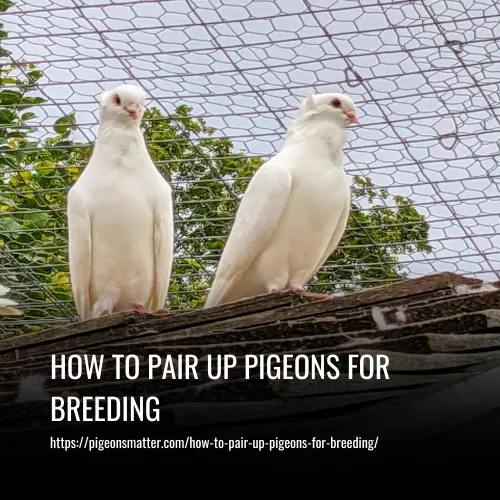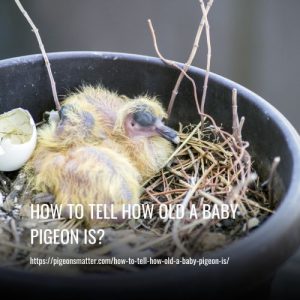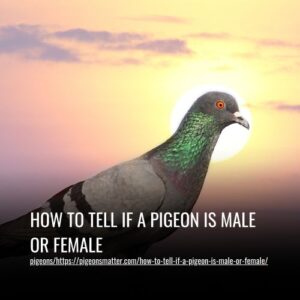Breeding pigeons requires careful consideration and understanding of how to pair up pigeons for optimal results. Whether you are an experienced breeder or just starting out, knowing how to select and pair pigeons can make a significant difference in the success of your breeding program.
To Pair Up Pigeons For Breeding, Follow These Steps:
- 1. Locking Them Up for a Night
- 2. Isolating Them in a Small Cage

How to Pair Up Pigeons for Breeding
When it comes to pairing up pigeons for breeding, there are two common methods that breeders use. The first method involves locking up the pigeons for a night, while the second method is isolating them in a small cage.
1. Locking Them Up for a Night
The most common method for pairing pigeons is to lock them up together for a night. This may initially seem unusual, but it provides the pigeons with an opportunity to mingle in the dark. It’s important to ensure that the pigeons have proper ventilation and are not kept confined during the day.
This method may take up to three nights or more for the pigeons to properly pair up, as they may initially engage in some fighting before eventually relaxing and forming a relationship.
2. Isolating Them in a Small Cage
Another method to pair up pigeons is to isolate them in a small wooden cage, separate from the rest of the birds. However, this method is less commonly used as people often lack an extra small cage and instead opt for the lock-up method. Isolating the pigeons in a large cage is not recommended as it does not bring them close enough to each other for pairing.
Pairing up pigeons for breeding requires patience and the right techniques. Whether you choose to lock them up for a night or isolate them in a small cage, allowing the pigeons to bond is essential for successful breeding.
Pigeon Pairing Habits
Pigeons, like Mourning Doves, are known for their monogamous pairs, often staying together and breeding in consecutive seasons as long as both birds are alive. This behavior is similar to mourning doves and reflects their ability to form strong and long-lasting bonds with their mates.
However, if one of the mates dies, the remaining pigeon will seek a new mate. Despite this, most pigeons will attempt to raise several broods each year, showing their dedication to the mating process and their desire to continue breeding.
This behavior is a natural part of the pigeon’s mating and reproductive cycle, and their pairs can last for as long as both birds are alive, with attempts to breed multiple times throughout the year.
How Long Does It Take For Pigeons To Pair Up
Pigeons typically take one night to pair up, although in some cases it may take up to three nights for them to establish a bond. This process of pairing is crucial for forming a strong and stable breeding pair.
How Do You Pair Pigeons Fast
To pair pigeons quickly, lock them up at night in one of the pigeon compartments/boxes inside the pigeon cage. This confinement overnight may help them bond and become a pair in the morning. However, it may take a couple more attempts before they successfully pair up.
When Should You Pair Your Pigeons
The breeding season for pigeons begins at the end of November. During this time, we look for a balance between large and small pigeons when pairing couples. It is important to note that two large or two small pigeons are almost never paired against each other.
The Care: Nutrition, Hygiene and Vitamins
Here are some important tips to pair up pigeons for breeding.
1. Nutrition
During the moulting period, all pigeons should be given a moulting mix and a regular dose of grit to promote digestion. The sharp edges of the grit help grind the food in the pigeon’s stomach, so it is not necessary to mix the grit with the food daily. A bath with a dash of vinegar and a tablespoon of salt should be given to the pigeons every now and then to stimulate moulting, while making sure not to leave the bath longer than one day.
2. Hygiene
It is important to maintain hygiene by regularly giving the pigeons a bath and ensuring that the bath is not left for longer than a day. This helps in stimulating moulting and prevents vermin infestations.
3. Vitamins
14 days before pairing, all breeding pigeons should be given general vitamins A, B, and D for 5 days to ensure that they are optimally healthy by the pairing date in November. These vitamins are crucial for the health of the pigeons during the breeding period.
FAQs
Yes, pigeons pair up naturally, both stray pigeons and pet pigeons. Stray pigeons will naturally pair up when they are out in the wild, while pet pigeons are often paired up by breeders or owners. However, pet pigeons can also pair up on their own if given the opportunity.
To get pigeons to mate, you need to provide them with the right conditions and a suitable environment. Allow them to mingle and interact with each other, and once they pair up, they will naturally mate. There is nothing specific you can do to push them to mate, as it is a natural process that occurs when the conditions are right.
Pigeons peck each other for various reasons, but one common reason is when they are defending their territory. Pigeons are protective of their nests or boxes, as well as their babies and partners. When other pigeons get too close, they may peck at them to assert dominance and protect their territory.
A pair of pigeons can have 10-16 pairs of squabs, or baby pigeons, in one year. It takes about 5-6 months for a squab to reach sexual maturity. The weight of a newborn squab is usually related to the weight of the egg.
To pair new pigeons, it is best to couple them beforehand if possible. You can place them in a “half-box” two to three weeks before the actual coupling. This allows the pigeons to get to know each other and become familiar with their partner, so they will immediately recognize and accept each other when the time comes.
While it is less common for two male pigeons to form a pair, it is possible for them to do so. Male birds usually view each other as competitors, but in some cases, they may form a bond and become extremely devoted to each other. They may still have squabbles, especially if they don’t have fake eggs to care for.
Yes, two female pigeons can mate. If you have two female pigeons and they are both in good health, they may form a bond and engage in mating behaviors. They can build a nest and take turns sitting on the eggs, just like a male and female pair would. However, it’s important to note that without a male pigeon, the eggs will not be fertile and will not hatch.
Male and female pigeons can be paired by allowing them to interact and observe each other’s behavior. Pigeons often engage in courtship behaviors such as bowing, cooing, and puffing up their feathers to attract a mate. By providing a suitable environment and allowing the pigeons to interact, they will typically recognize each other as mates.
Pigeons can move in pairs or in larger groups. It is not uncommon to see pairs of pigeons flying together, but they can also form larger flocks. The size of the flock can depend on factors like food availability, water availability, time of day, and weather conditions.
Signs of pigeons mating include the male pigeon bowing, cooing, inflating his throat, and strutting around the female in a circle. They may also preen each other and the male may grasp the female’s bill and regurgitate food as a courtship gesture. When the female is ready to mate, she will crouch and the male will jump on her back.
Pigeons can breed year-round, but in most areas, there are two main breeding seasons. The first season is from March to June, and the second season is from August to November. Eggs typically hatch 18 days after being laid, and a second clutch of eggs is usually laid about 46 days after the previous clutch.
Conclusion
In conclusion, pairing up pigeons for breeding requires careful consideration of genetics, health, and behavior. By understanding the principles of breeding and genetics, pigeon breeders can make informed decisions that contribute to the overall health and quality of their flock. It’s important to prioritize the welfare of the birds and ensure that the pairings are beneficial for both individuals involved.
Observing the behavior of potential pairs can also provide valuable insight into their compatibility and likelihood of successful breeding. By carefully monitoring interactions and nesting behaviors, breeders can identify potential issues and make adjustments as needed.


